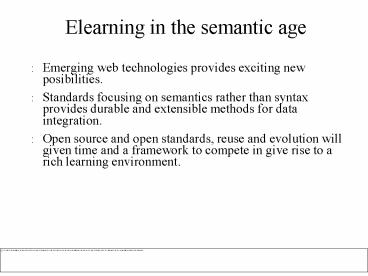Elearning in the semantic age PowerPoint PPT Presentation
1 / 10
Title: Elearning in the semantic age
1
Elearning in the semantic age
- Emerging web technologies provides exciting new
posibilities. - Standards focusing on semantics rather than
syntax provides durable and extensible methods
for data integration. - Open source and open standards, reuse and
evolution will given time and a framework to
compete in give rise to a rich learning
environment.
2
Our vision
- Lerner motivation is crucial, a learning
environment need to be inspiring and trigger
curiosity. - Content managementCourse/content creation,
portfolios, profiles, annotations, etc. - Knowledge navigationSeparation of content and
context - Experience-oriented environmentsVirtual
communities, 3D-environments
3
Three problems with current approaches
- Teaching models remains unchanged
- Canned books / taped lectures
- Email correspondence school
- Multiple choice test
- Perspective on metadata is too limited.
- Definitive instance
- Diversity
- Monolithic proprietary systems will not easily
adapt to new standards
4
Proposed solutions
- Learner-centric educational architectures
- Knowledge Manifold / Conceptual
WebInterest-based knowledge pulling - Semantic Web layer
- A distributed metadata language RDF. Achieving
semantic interoperability, extensibility and
reusability are some of the goals. - A Learning Framework
- A layered open architecture where independent but
cooperating applications present the user with a
smorgosbord of learning offerings.
5
Anyone can say anything about anything
- SW-techniques allow you to add metadata to
distributed resources just like html allows you
to link to such resources. - Metadata is not bound to a fixed description
format (schema), i.e. you may invent a
description format of your own.
6
Things you can do with SW
- Express metadata about remote resources
- Add personal annotations
- Extend content, versions may split, evolve and
merge - Certify resources
7
Introducing the Learning Framework
- Not monolithic
- Layered open Architecture
- Pluggable architecture
- Open Standards
- Open source
- Simplify
- Metadata exchange
- Application development
8
(No Transcript)
9
Some examples
- EdutellaBasic infrastrucutre for metadata
exchange - ConzillaOur conceptbrowser
- Portfolios
10
Edutella
- PADLR projectKTH, Stanford, Uppsala, L3S,
Karlsruhe - Technology
- P2p technology (connecting providers and
learners) - Exchange of metadata (expressed in RDF)
- Services
- Search
- Map
- Replicate

